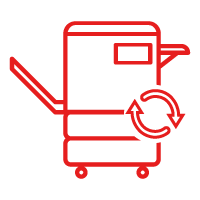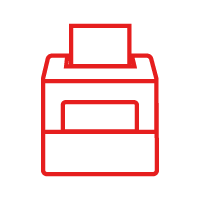-
Industry
SolutionsIndustry
SolutionsTeam with a technology partner that delivers across all industries.
Read more about industry solutions -
Software
SolutionsSoftware
SolutionsLearn how to optimise your business processes to save time and increase productivity.
Read more about software solutions -
Services
-
Products
Products
Feel confident knowing your technology will deliver reliability and longevity as you move forward.
Read more about productsMultifunctionEnhance your operational and financial performance with Toshiba's award-winning range.
Read more about multifunction Software
SoftwareSave money, better manage documents, secure critical information and improve efficiency.
Read more about software Pre-Owned MFDs
Pre-Owned MFDsQuality pre-owned A3 Multi-Function Devices (MFDs) fully refurbished by master manufacturer-trained technicians.
Read more about refurbished MFD Barcode Printer
Barcode PrinterToshiba Auto-ID, Barcode and Label printers are the perfect solution for everyday business.
Read more about barcode printer Printers
PrintersDesigned to deliver power and performance to small businesses and workgroups.
Read more about printers Interactive Flat Panels
Interactive Flat PanelsCreate inspired learning and smarter corporate collaboration
Read more about IFPs
-
Support
Support
We are here to help! Discover and access information about your Toshiba products or simply contact us for priority service.
Read more about support -
Company
Company
Toshiba is the world's most trusted provider of industry-targeted solutions that help increase the value of ideas and information.
Read more about company
 Collaboration is the name of the game in today’s educational environment. Collaboration between teachers and other school staff; between students working together on assignments and projects; and between teachers and students for sharing teaching materials. In a school, there may be many different groups collaborating – groups that are dynamic in nature, with new ones being created, and team members joining and leaving as the project progresses. Collaboration in education centres around documents – information that needs to be co-created, shared, approved, and updated by team members and stored where everyone can find it.
Collaboration is the name of the game in today’s educational environment. Collaboration between teachers and other school staff; between students working together on assignments and projects; and between teachers and students for sharing teaching materials. In a school, there may be many different groups collaborating – groups that are dynamic in nature, with new ones being created, and team members joining and leaving as the project progresses. Collaboration in education centres around documents – information that needs to be co-created, shared, approved, and updated by team members and stored where everyone can find it.
Microsoft Teams – the strengths and the issues
Many schools use Microsoft Teams as a way to manage collaboration – it enables the sharing of documents (based on OneDrive and SharePoint), and also provides tools for online meetings and chats. However, when it comes to managing the upload of documents into Teams, and the search and retrieval, many schools would agree that the process isn’t always streamlined, and can take a bit of effort. The problems they encounter include:
- Scanning time: uploading documents into teams is a multi-step, time-consuming process - with students, teachers or administrators having to scan the documents and then manually upload them into the appropriate folder.
- Complex scans: if some of the items to be scanned are not straightforward cut sheets – for example, they are bound books, or even 3D objects – scanning can take even longer, as pages have to be manually merged into the same document.
- Finding documents – for students and staff alike, finding the document they want to read and/or print can be time-consuming, especially if the filing system is not the most intuitive. Documents tend to be shared between people who are in the same team. Yet filing system structures often don’t map to team structures and assignments.
- Managing workflows – some documents need to go to a specific user for processing, such as a form that needs approval. Managing these workflows takes time and effort.
Kōdo app for Microsoft Teams
Toshiba works closely with schools across Australia, and understood that there was scope for greater efficiency in the use of Teams. So they developed a solution - Kōdo Application for Teams. Kōdo for Teams streamlines the process of uploading to and printing documents from Teams, helping schools to get the most out of their investment in Microsoft technology.
Within the Kōdo for Teams app, the school sets up teams – for example, a class could be a team – and within each team, a number of channels. A channel could be a group within the class who are collaborating on a project or assignment. Or a team could be the school administrators, and a channel could be the finance or bursar department.
A channel stores everything associated with that project or role – documents (Word, PowerPoint or PDF), images, communications, and workflows. Each channel can set its own security parameters and permissions, right down to document level, and can be set up to look exactly like SharePoint or OneDrive.
The student or staff member logs into the app via a tablet-like panel on the Toshiba Multi-Function Device (MFD). Once they are authenticated, they see all the teams to which they belong, and as they select a team, they see their channels and the all the documents associated with it. They can scan, browse or retrieve documents directly to/from the channel:
- Scan – the Kōdo for Teams app allows users to scan in different formats – such as cut sheets, pages from bound books and even 3D objects – and integrate them into a single document. They build the job from the panel on the MFD and are shown a thumbnail to check the content before submitting to the filing system.
- Batch separation – this makes scanning faster, by allowing the staff member or student to scan a number of documents in one pass, and have them automatically separated by the system, based on a number of pages per document, or a separator, such as a barcode. Batch separation streamlines the upload process for maximum efficiency.
- Retrieval and print - From the MFD users can select and print the documents they need for a class, or a groupwork session, with no need to go via their laptop or PC. They can also use all the additional MFD functions to manage the document – including double sided print, stapling and hole punch.
Kōdo app for Microsoft Teams is fully integrated with Microsoft Teams, and operates dynamically, meaning that if a student or staff member has been allocated to a new team or channel, they will automatically see that channel’s documents.
Kōdo app for Microsoft Teams is developed in Australia, specifically for the needs of Australian schools. It is designed to be straightforward and intuitive, so that teachers and students do not need training to use it.
Get in touch
If your school uses Microsoft Teams and you’re looking to maximise the value of that investment by streamlining the process of collaboration, talk to us at Toshiba. We’ll help you get the best from your Microsoft platform and ensure that staff and students are working at maximum efficiency.
